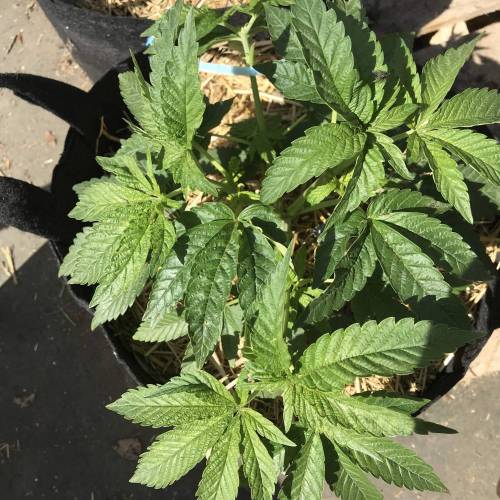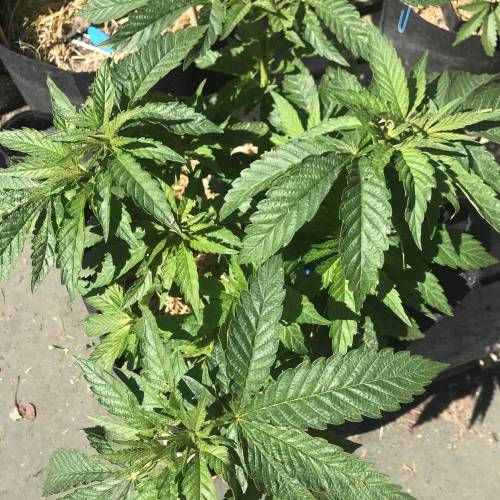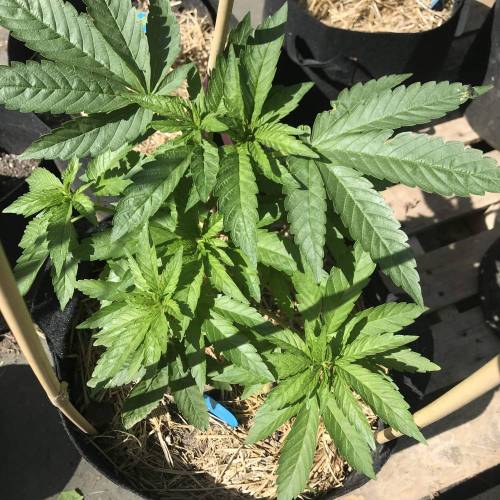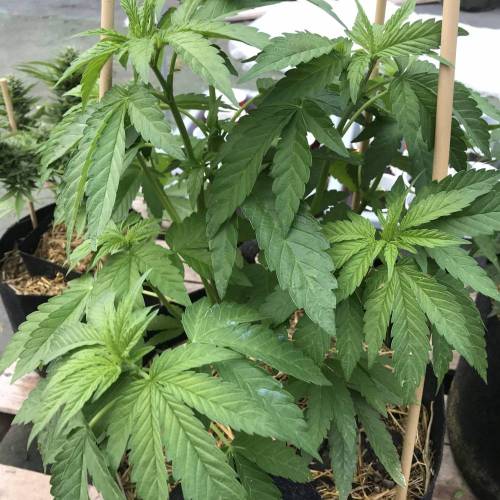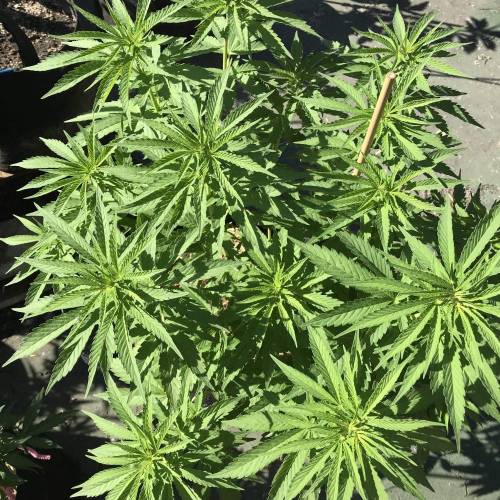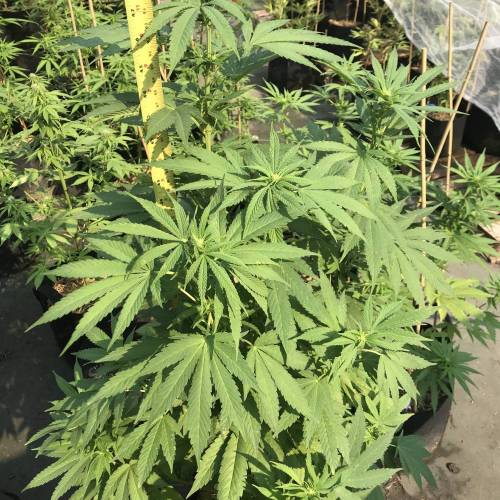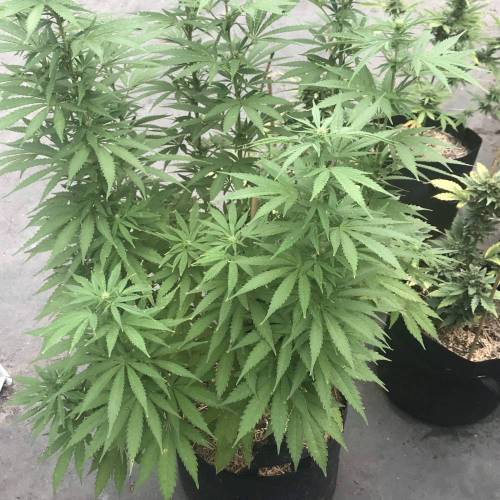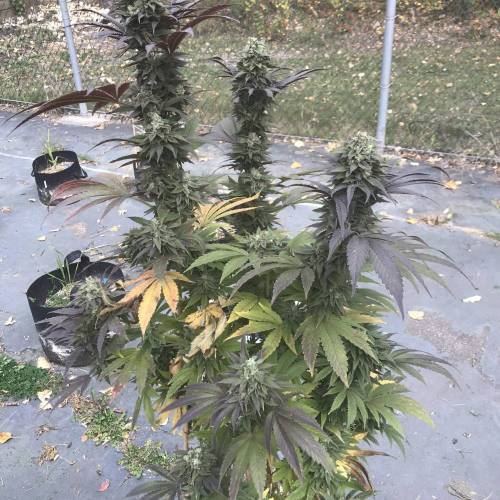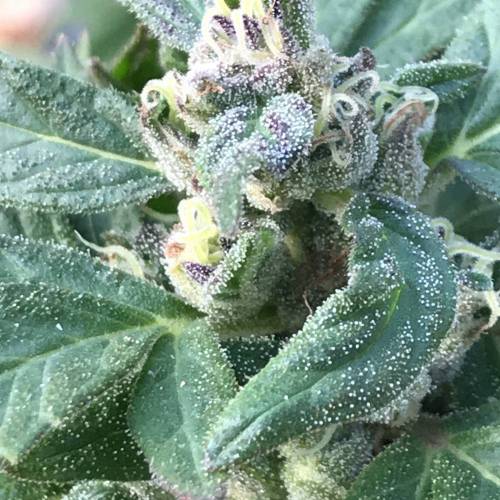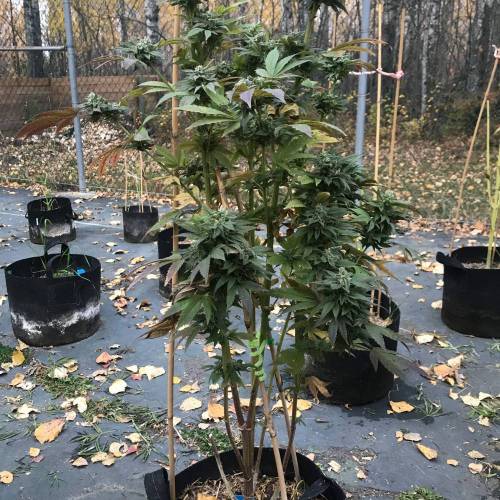The Grow Awards 2026 🏆 








Wonder Pie 2021 Season 2
Soil
Custom
Perlite
Custom
Other
Custom
Outdoor
Room Type
Defoliation
weeks 17
Topping
weeks 5, 8
LST
weeks 8-10
27 liters
Pot Size
2.5 liters
Watering
Start at Harvest
G
Germination5y ago
Northern_Ent Started 2 seeds at same time as Gelato and Gorilla Glue on March 20. One popped, one didn’t. Started third WP seed on March 28.
4 likes
1 comment
Share
Used method
Glass Of Water
Germination Method
1
Week 1. Vegetation5y ago
2 cm
Height
18 hrs
Light Schedule
22 °C
Day Air Temp
50 %
Air Humidity
16 °C
Night Air Temp
Northern_Ent Going fine. My indoor setup is pretty iffy but it’s only to germinate seeds and get them started. Nice weather this spring but it was cold today, about -20 C with the wind chill. Here, if you wait til it’s nice enough to start seeds outdoors you’re waiting until late May.
Small humidifier arrived today so the seedlings now don’t have to suffer through 30-35%RH at this time of year.
1 like
comments
Share
2
Week 2. Vegetation5y ago
2 cm
Height
16 hrs
Light Schedule
18 °C
Day Air Temp
60 %
Air Humidity
15 °C
Night Air Temp
1 like
comments
Share
3
Week 3. Vegetation5y ago
5 cm
Height
16 hrs
Light Schedule
18 °C
Day Air Temp
60 %
Air Humidity
15 °C
Night Air Temp
Nutrients 1
Natures Sorce
4 mll
Northern_Ent Second Wonder Pie germinated so 2/3 this round. She’s about a week behind.
Fertilized first time April 6 Day 17.
1 like
comments
Share
4
Week 4. Vegetation5y ago
3.94 cm
Height
16 hrs
Light Schedule
18 °C
Day Air Temp
60 %
Air Humidity
15 °C
Night Air Temp
Nutrients 2
Barley sprouts
2 mll
LAB
10 mll
Northern_Ent April 12 Day 23
Watered with 2 g (1 tsp) of barley sprouts dissolved in 1 L of water. This increased water TDS from 134 ppm to 190 ppm. Barley sprouts have a high nitrogen content (13-15%) so this might represent about 10 mg/L N dissolved in water.
LAB are lactic acid bacteria, and these are being used at 1:250 dilution as a spray on plant and soil surface.
April 13: first day in greenhouse for WP1. Warm enough to have in greenhouse for the afternoon.
April 14: another nice day in greenhouse. Applied barley sprouts again and sprayed LAB on plant and soil at lights out. Plants have perked up after transplanting and look appropriately green so they’re likely getting enough N from the barley sprouts.
April 15: more afternoon sun and applied first barley SST.
April 17: LAB dilution changed to 1:100 and sprayed on leaves and soil at lights out.
1 like
1 comment
Share
5
Week 5. Vegetation5y ago
10 cm
Height
16 hrs
Light Schedule
18 °C
Day Air Temp
5.9
pH
530 PPM
TDS
50 %
Air Humidity
18 °C
Night Air Temp
Nutrients 5
Barley sprouts
4 mll
LAB
10 mll
Blackstrap molasses
2 mll
Northern_Ent April 19: watered with barley sprouts and Nature’s Source. Sprayed soil and leaves at lights out with LAB, and potassium silicate.
4/20 😎.
April 22: morning water with barley sprouts, molasses, and vinegar to get pH near 6. Sprout solids applied as top dressing on soil. Plants looked good this morning.
April 23: topped WP1 and applied some barley SST with some solids as top dressing. Still too cold to be put outside so I’ll delay transplanting a bit longer.
April 25: looks good but yellowing on new growth later in day indicates magnesium deficiency. Pinch of Epsom salts (magnesium sulphate) in spray bottle fixed that amazingly quickly. As a deficiency that might be due to the cold. It was nicely sunny today but ground is still cool and I noticed the chlorosis after she had been sitting on the ground for a while. Also another foliar spray at lights out (LAB @ 1:50 dilution, KSiO4 at 1:2000 dilution, and another pinch of MgSO4).
April 26: yellowing indicates a magnesium deficiency and I suspect that is due to the high sodium levels in the well water and the relatively cool temperatures. Sprayed with some Epsom salts and calcium citrate in water which seems to help but the real problem is the cation ratio in the source water (95% sodium).
The SAR (sodium adsorption ratio) for this water is super high at 20 which is the worst category where >15 is “unacceptable do not use”. Yikes.
So, the garden soil needs gypsum, and the water needs to be hardened by exchanging sodium for calcium and magnesium.
3 likes
comments
Share
Used techniques
Topping
Technique
6
Week 6. Vegetation5y ago
15 cm
Height
16 hrs
Light Schedule
18 °C
Day Air Temp
5.9
pH
530 PPM
TDS
50 %
Air Humidity
18 °C
Night Air Temp
Nutrients 3
LAB
20 mll
FPJ - Dandelion Greens
1.5 mll

Pro-silicate
0.5 mll
Northern_Ent April 26: yellowing (chlorosis) indicates magnesium deficiency. This is due to a combination of cold temps and high sodium content in the water here. This creates a high SAR (sodium adsorption ratio) so this water needs to be re-balanced by exchanging Na for Ca/Mg.
Foliar spray with Epsom salts and a crushed calcium citrate pill in 1 L of water as a temporary fix for the plants.
Keep spraying with Epsom salts as it seems to fix the deficiency. So, likely magnesium due to cold and high sodium in source water.
April 28: first fermentation of dandelion greens seems to have worked well. Used at 1.5 mL/L for first try as a foliar spray but will normally be at 2 mL/L. Lights out foliar spray of LAB, FPJ, and potassium silicate.
April 29: transplanted into 7 gallon bags. Too much N by the look of things. FPJ and Barley sprouts are both pretty potent and likely lots of potassium which will also mess with cation exchange. Combined with high SAR water this is tough to keep balanced. Easy on the nutes for a while I think, and need to fix water supply chemistry.
April 30: nice in afternoon second day in a row. 😎
May 2: only 2C last night. Plants were left out with a plastic cover due to space constraints inside the warm room. Brought inside this morning to stay under lights today.
May 3: foliar spray (12 mL/L LAB, 2 mL/L FPJ, two drops Dr Bonners Peppermint soap as a surfactant) at lights out. Plants look good the next morning.
2 likes
8 comments
Share
7
Week 7. Vegetation5y ago
20 cm
Height
16 hrs
Light Schedule
18 °C
Day Air Temp
5.9
pH
900 PPM
TDS
50 %
Air Humidity
18 °C
Night Air Temp
Nutrients 5
LAB
20 mll
FPJ - Dandelion Greens
2 mll
Apple cider vinegar
0.5 mll
Northern_Ent May5: nice outside today and overnight low is not great but good enough (4C) to leave outside. That should be it for spring frost risk this year. 🤞
WP2 was badly burned by early cation imbalance in the water and I think this was exacerbated by high K in the barley sprouts. Removed a couple of badly damaged fan leaves.
May 6: looking better today. Watered in late morning with barley sprouts. WP2 is looking much better. Lights out foliar spray (LAB, FPJ, apple cider vinegar, peppermint soap).
May 8: looking okay but it’s definitely a bit too cool and rainy today. These plants are outside full time now and overnight low tonight is forecast at 0 C again. Gave FPJ, LAB, vinegar and soap foliar spray in evening. FPJ likely has lots of Phosphorus which is supposedly good for dealing with low temperatures.
Barley sprouts seem quite potent with lots of N, P and K. I need to cut way back on these until I get the excess sodium in the water sorted out.
May 9: cold again last night (+1C) and zero forecast for tonight. Plant is still doing okay despite low overnight temps.
2 likes
comments
Share
8
Week 8. Vegetation5y ago
20 cm
Height
18 hrs
Light Schedule
18 °C
Day Air Temp
5.9
pH
600 PPM
TDS
50 %
Air Humidity
23 °C
Solution Temp
10 °C
Night Air Temp
26.5 liters
Pot Size
Nutrients 7
LAB
20 mll
FPJ - Dandelion Greens
1 mll
Apple cider vinegar
0.5 mll
Northern_Ent May 14: looking good after Cal-Mag boost and barley SST last night.
May 15: topped in morning. Four main cola growth tips were removed. This is the second time topping this plant.
May 16: bit of LST to open it up to the sun.
Everybody got sprayed with dilute FPJ and calnesium and then they all got a bit of a flush with low sodium water and 3 mL/L of calnesium. Looks good.
3 likes
1 comment
Share
Used techniques
LST
Technique
Topping
Technique
9
Week 9. Vegetation5y ago
20 cm
Height
18 hrs
Light Schedule
12 °C
Day Air Temp
6.2
pH
800 PPM
TDS
50 %
Air Humidity
21 °C
Solution Temp
10 °C
Night Air Temp
26.5 liters
Pot Size
Nutrients 4
LAB
20 mll
FPJ - Dandelion Greens
1 mll
Dr Bonners Peppermint Soap
0.1 mll
Northern_Ent May 18: start of 3 days of cold and rain.
May 19: about 0 C last night but plants seem okay as they were covered. Foliar spray at 11 am.
May 20: watered last night and this morning using warmed water. Was about 0 C overnight. Foliar spray at 7 pm and then warmed water at 9:30 before being covered for the night.
May 22: weed FPJ at 1 mL/L.
May 23: LAB only foliar at 20 mL/L.
May 25: released the LST tie downs leaving the south facing one in place.
3 likes
9 comments
Share
Used techniques
LST
Technique
10
Week 10. Vegetation5y ago
20 cm
Height
18 hrs
Light Schedule
16 °C
Day Air Temp
6.2
pH
800 PPM
TDS
50 %
Air Humidity
21 °C
Solution Temp
10 °C
Night Air Temp
26.5 liters
Pot Size
Nutrients 1
LAB
20 mll
Northern_Ent May 28: tied WP2 to lean it northward to catch more sunlight.
1 like
comments
Share
Used techniques
LST
Technique
11
Week 11. Vegetation5y ago
48.26 cm
Height
18 hrs
Light Schedule
20 °C
Day Air Temp
6.2
pH
800 PPM
TDS
50 %
Air Humidity
21 °C
Solution Temp
10 °C
Night Air Temp
7 liters
Pot Size
2.01 liters
Watering Volume
Nutrients 2
LAB
20 mll
Alaska Fish Fertilizer
6 mll
Northern_Ent June 2: sunny and hot again 31 C.
It was at or below zero for five nights ending about 12 days ago. Now it’s peak summer sort of hot. Overnight temps are now about 12-15 C.
June 3: run of hot sunny weather and now WP1 is looking really good. There is at least another month of veg before I start force flowering so this one could get pretty huge.
June 5: LAB silicate and soap foliar this afternoon. Small hail storm but no plant damage.
June 8: fish fertilizer foliar for N in afternoon. LAB foliar at dusk. Cooler today only about 17 C.
3 likes
1 comment
Share
12
Week 12. Vegetation5y ago
66.04 cm
Height
18 hrs
Light Schedule
22 °C
Day Air Temp
6.2
pH
800 PPM
TDS
50 %
Air Humidity
21 °C
Solution Temp
11 °C
Night Air Temp
26.5 liters
Pot Size
2.84 liters
Watering Volume
Nutrients 3
LAB
15 mll
Alaska Fish Fertilizer
4 mll
FPJ - nettles
0.5 mll
Northern_Ent June 15: thunderstorms yesterday and today. Plants look good and WP2 has passed the older WP1 for height.
1 like
comments
Share
13
Week 13. Vegetation5y ago
73.66 cm
Height
18 hrs
Light Schedule
22 °C
Day Air Temp
6.2
pH
800 PPM
TDS
50 %
Air Humidity
21 °C
Solution Temp
11 °C
Night Air Temp
26.5 liters
Pot Size
2.84 liters
Watering Volume
Nutrients 5
LAB
15 mll
Alaska Fish Fertilizer
4 mll
Barley Sprouts
1 mll
Northern_Ent June 16: looks like WP1 is starting to flower.
This is an interesting plant cuz it seems to autoflower later than regular autos. It’s not to the solstice yet, with 18+ h days here, and yet it’s starting to flower. I noticed this last year when DaleMac’s plants started flowering early.
So here in Alberta it started flowering in mid-June after 12 weeks of veg this year, and last year with a later start it was in early August after 10 weeks of veg. DaleMac’s started flowering after 9 weeks in California last year. That means it’s kind of an auto despite being a photoperiod, or vice versa. Seems like a nice trait for outdoor growing this far North.
June 20 and 22: full foliar at dusk.
June 22: new growth was a bit yellow this afternoon, so she got an Epsom salts and fish fertilizer foliar in the afternoon. Noticeably greener in the evening.
4 likes
1 comment
Share
14
Week 14. Flowering5y ago
83.82 cm
Height
18 hrs
Light Schedule
33 °C
Day Air Temp
6.2
pH
800 PPM
TDS
50 %
Air Humidity
21 °C
Solution Temp
15 °C
Night Air Temp
26.5 liters
Pot Size
2.84 liters
Watering Volume
Nutrients 6
LAB
15 mll
Alaska Fish Fertilizer
4 mll
FFJ - watermelon, strawberry and banana
0.5 mll
Northern_Ent June 25: heat wave starting...about a week of 30 + C is forecast. Used FFJ and WSC for first time as part of the foliar at dusk.
June 29: still in heat wave although it’s now cooled to only 35 C. Yesterday was 36 C, and tomorrow should be the last really hot day. Normal here at this time of year is about 23 C and all time records are being broken.
Yesterday a village in BC that is always the hottest spot in the province hit 49.5 C (121 F) which is the highest temperature ever in Canada.
Anyway the plants are mostly okay with regular misting, some shade, and foliar sprays with kelp and cal-mag. We’ll all be happier once it cools down a bit.
5 likes
3 comments
Share
15
Week 15. Flowering4y ago
76.2 cm
Height
18 hrs
Light Schedule
33 °C
Day Air Temp
6.2
pH
800 PPM
TDS
50 %
Air Humidity
21 °C
Solution Temp
15 °C
Night Air Temp
26.5 liters
Pot Size
2.84 liters
Watering Volume
Nutrients 7
LAB
25 mll
Alaska Fish Fertilizer
4 mll
FFJ - watermelon, strawberry and banana
1 mll
Northern_Ent Still super hot.
37 C three days in a row.
July 3 heat wave finished.
1 like
1 comment
Share
16
Week 16. Flowering4y ago
93.98 cm
Height
18 hrs
Light Schedule
29 °C
Day Air Temp
6.2
pH
800 PPM
TDS
50 %
Air Humidity
21 °C
Solution Temp
15 °C
Night Air Temp
26.5 liters
Pot Size
2.84 liters
Watering Volume
Nutrients 7
LAB
25 mll
Alaska Fish Fertilizer
2 mll
FFJ - watermelon, strawberry and banana
1 mll
likes
comments
Share
17
Week 17. Flowering4y ago
109.22 cm
Height
16 hrs
Light Schedule
21 °C
Day Air Temp
6.2
pH
850 PPM
TDS
50 %
Air Humidity
21 °C
Solution Temp
13 °C
Night Air Temp
26.5 liters
Pot Size
2.84 liters
Watering Volume
Nutrients 7
LAB
30 mll
Alaska Fish Fertilizer
4 mll
FFJ - watermelon, strawberry and banana
1 mll
Northern_Ent July 16: started force flowering of photoperiods in the grow area. Plan to continue 9 pm to 9 am covering until the end of July (two weeks).
July 19: fish dose back up to 4 mL/L as the plants are too yellow.
2 likes
1 comment
Share
Used techniques
Defoliation
Technique
18
Week 18. Flowering4y ago
119.38 cm
Height
16 hrs
Light Schedule
21 °C
Day Air Temp
6.2
pH
850 PPM
TDS
50 %
Air Humidity
21 °C
Solution Temp
13 °C
Night Air Temp
26.5 liters
Pot Size
2.84 liters
Watering Volume
Nutrients 7
LAB
20 mll
Alaska Fish Fertilizer
4 mll
FFJ - watermelon, strawberry and banana
1 mll
Northern_Ent I just found out Frenchy Cannoli died a couple of days ago (18 July 2021). He was ‘the’ master hash maker (hashinin) and anyone wanting to learn how make hash should check him out on YouTube. Thanks Frenchy.
July 22: cutting back on LAB (20 mL/L) just because I’m running low and the next batch will be another week.
2 likes
2 comments
Share
19
Week 19. Flowering4y ago
124.46 cm
Height
16 hrs
Light Schedule
26 °C
Day Air Temp
6.2
pH
850 PPM
TDS
50 %
Air Humidity
21 °C
Solution Temp
13 °C
Night Air Temp
26.5 liters
Pot Size
2.84 liters
Watering Volume
Nutrients 7
LAB
30 mll
Alaska Fish Fertilizer
4 mll
FFJ - watermelon, strawberry and banana
1 mll
3 likes
comments
Share
20
Week 20. Flowering4y ago
124.46 cm
Height
16 hrs
Light Schedule
26 °C
Day Air Temp
6.2
pH
850 PPM
TDS
50 %
Air Humidity
21 °C
Solution Temp
13 °C
Night Air Temp
26.5 liters
Pot Size
2.84 liters
Watering Volume
Nutrients 8
LAB
30 mll
Alaska Fish Fertilizer
4 mll
FFJ - watermelon, strawberry and banana
1 mll
Northern_Ent Looking pretty good if not optimally pruned.
All plants got a few rounds of Mega Crop to get enough N. Also doing some targeted sprays for yellowy plants using fish fertilizer, Epsom salts and water soluble calcium (WCS). Many plants need more N so I’ve been trying to add more.
4 likes
comments
Share
21
Week 21. Flowering4y ago
124.46 cm
Height
16 hrs
Light Schedule
27 °C
Day Air Temp
6.2
pH
850 PPM
TDS
50 %
Air Humidity
21 °C
Solution Temp
13 °C
Night Air Temp
26.5 liters
Pot Size
2.84 liters
Watering Volume
Nutrients 8
LAB
30 mll
Alaska Fish Fertilizer
4 mll
FFJ - watermelon, strawberry and banana
1 mll
3 likes
5 comments
Share
22
Week 22. Flowering4y ago
124.46 cm
Height
16 hrs
Light Schedule
27 °C
Day Air Temp
6.2
pH
850 PPM
TDS
50 %
Air Humidity
21 °C
Solution Temp
13 °C
Night Air Temp
26.5 liters
Pot Size
2.84 liters
Watering Volume
Nutrients 4
LAB
30 mll
FFJ - watermelon, strawberry and banana
1 mll
WSC - water soluble calcium
2 mll
Northern_Ent I started the Wonder Pies much earlier this year, but the plants are no bigger with the longer veg time.
1 like
3 comments
Share
23
Week 23. Flowering4y ago
124.46 cm
Height
16 hrs
Light Schedule
24 °C
Day Air Temp
6.2
pH
850 PPM
TDS
50 %
Air Humidity
21 °C
Solution Temp
10 °C
Night Air Temp
26.5 liters
Pot Size
2.84 liters
Watering Volume
Nutrients 4
LAB
30 mll
FFJ - watermelon, strawberry and banana
1 mll
WSC - water soluble calcium
2 mll
2 likes
comments
Share
24
Week 24. Flowering4y ago
124.46 cm
Height
14 hrs
Light Schedule
24 °C
Day Air Temp
6.2
pH
Normal
Smell
850 PPM
TDS
50 %
Air Humidity
10 °C
Night Air Temp
26.5 liters
Pot Size
2.5 liters
Watering Volume
Nutrients 5
LAB
30 mll
FFJ - watermelon, strawberry and banana
1 mll
WSC - water soluble calcium
2 mll
Northern_Ent Added fish fertilizer back into foliar spray mix as plants needed more N.
Sep 6: sunny and warm last few days and it shows. 😎
3 likes
1 comment
Share
25
Week 25. Flowering4y ago
124.46 cm
Height
13 hrs
Light Schedule
21 °C
Day Air Temp
6.2
pH
Normal
Smell
850 PPM
TDS
5 °C
Night Air Temp
26.5 liters
Pot Size
2.5 liters
Watering Volume
Nutrients 5
LAB
30 mll
FFJ - watermelon, strawberry and banana
1 mll
WSC - water soluble calcium
2 mll
1 like
1 comment
Share
26
Week 26. Flowering4y ago
124.46 cm
Height
12 hrs
Light Schedule
21 °C
Day Air Temp
6.2
pH
Normal
Smell
850 PPM
TDS
5 °C
Night Air Temp
26.5 liters
Pot Size
2.5 liters
Watering Volume
Nutrients 4
LAB
50 mll
FFJ - watermelon, strawberry and banana
2 mll
WSC - water soluble calcium
2 mll
Northern_Ent Sep 28: fall colours and trichomes look great together. 😎👍
likes
1 comment
Share
27
Week 27. Flowering4y ago
124.46 cm
Height
12 hrs
Light Schedule
21 °C
Day Air Temp
6.2
pH
Normal
Smell
850 PPM
TDS
5 °C
Night Air Temp
26.5 liters
Pot Size
2.5 liters
Watering Volume
Nutrients 3
LAB
50 mll
FFJ - watermelon, strawberry and banana
2 mll
WSC - water soluble calcium
2 mll
Northern_Ent Sep 29: still going in Week 27 so now past six months. Sheesh. Flowers are finally starting to pack on some weight. My grow area is getting shaded now so the lack of direct sun is likely not good.
Starting these earlier didn’t get them much bigger compared to last year, but still one of my favourite plants.
2 likes
comments
Share
28
Week 28. Flowering4y ago
124.46 cm
Height
12 hrs
Light Schedule
21 °C
Day Air Temp
6.2
pH
Normal
Smell
850 PPM
TDS
5 °C
Night Air Temp
26.5 liters
Pot Size
2.5 liters
Watering Volume
Nutrients 3
LAB
50 mll
FFJ - watermelon, strawberry and banana
2 mll
WSC - water soluble calcium
2 mll
Northern_Ent Oct 3: grow area is now mostly shaded.
Nice cherry like smell I remember from last year.
Oct 4: harvested top colas from both plants. The buds are not as good as last year likely because of lack of direct sun in the grow area starting in mid-September.
Oct 7: hit -5 C and was below 0 C for about 12 hours. Frost on buds in morning so harvesting final plants.
2 likes
comments
Share
28
Week 28. Harvest4y ago
Happy Harvest Day!

8/10
Rated
Nice plants were force flowered for the last two weeks in July. Should have been forced two weeks earlier as the buds needed stronger sunlight to develop fully. Last year’s buds were better because of a lack of direct sunlight in my licensed grow area this year starting in early September.
Show more
Translate
Spent 198 days
Ger Veg Flo Har
300 g
Bud wet weight per plant
75 g
Bud dry weight per plant
2
Plants
Easy
Difficulty

Creative, Hungry
Positive effects

Earthy, Flowery, Fruity
Taste
Height
Day air temperature
Air humidity
PPM
PH
Light schedule
Solution temperature
Night air temperature
Pot size
Northern_Ent Nice plants were grown using KNF methods. There was a lack of sunlight during late flower so the final buds were not as good as last year but still pretty good.
Nice flavour and smoke. Always a favourite.
3 likes
2 comments
Share
Equipment Reviews

the end.
Enjoying this diary? Follow for more updates!
Prefer the old Diary view?
Go back to the old Diary view









































































